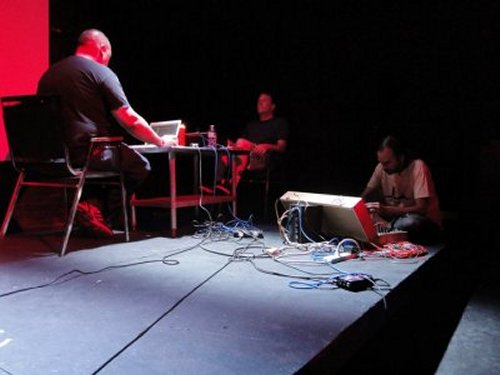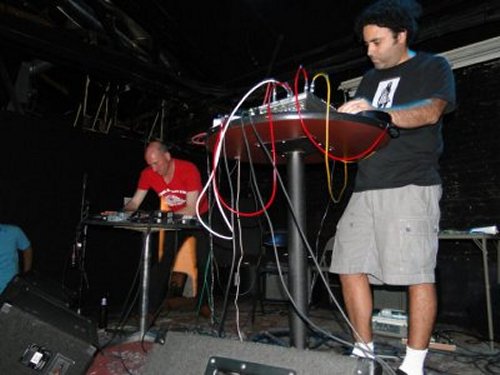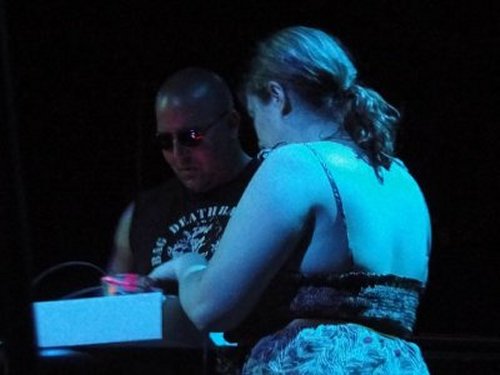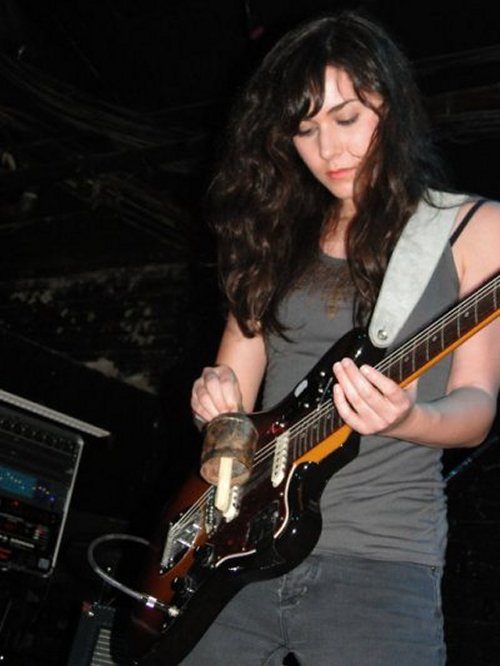| « Review: Autolux @ Bottom Lounge 8/20 | Review: Slayer @ UIC Pavillion, 8/20/10 » |
Concert Sun Aug 22 2010
Neon Marshmallow Festival - Day Three wrapup

Day three of the Neon Marshmallow Fest at the Viaduct Theater, the most endurance-defying yet, has come and gone. Starting at noon and going well into the 3 a.m. hour with only an hour break for dinner, it was die-on-your-feet-or-live-slumped-in-theater-seating, and, by night's end, certain shows turned into little slumber parties, with people soaking up the electronic waves from a prone position. Some of the best performances of the fest happened today (sez me), and one loathsome event marred the night permanently. Read on....
I rolled in part-way through U.S. Girls' spot on the mainstage and was treated to immediate, blissful hypnosis. Waves of grainy looping passages, fragments of music, and Megan Remy's earthy, mysterious vocals intoning over it all. The thick fuzz mottling the loops enhanced the music's fragile beauty.
Preyers An unexpected solo fill-in spot from Emeralds' Mark McGuire offered more guitar-and-pedal-rack meditations, with a decidedly water/bubbly-sounding palette much of the time.
I hope you'll continue to read the rest of these wrapups even though I will tell you now that nmperign & Jason Lescalleet were the BEST OF THE FEST. Ding ding, no more calls, we have a winner. I had high hopes for the set, but I would never have been so greedy as to ask for this. Starting slowly and haltingly, Lescalleet spent the first three or four minutes of the set running a single tape loop and rummaging through his suitcase for misplaced equipment. Little by little, Bhob Rainey and Greg Kelley's alien transmissions fed into the rotted tape loop (unlike fellow loop guru Joseph Hammer, Lescalleet prefers to keep his tape loops pinched, mangled, and dirty -- no clean white gloves here), accumulating small details while the tangled mass of mixers, filters, tapes, and budget-line keyboards were routed and re-routed. The organ-sound of the loop reminded one fest-goer of Hermann Nitsch, and the middle section, during which Bhob blew stuttering electronic-sounding flutters into his mouthpiece-less soprano sax and Kelley taunted his trumpet with thin slices of metal, took on an early Organum quality — the really loud stuff, like "Pulp," y'know. Lescalleet switched tape players, pervasively changing the sound field in the mix, spurring Kelley and Rainey to new textures, the three operating in union, playing in perfect sync, coaxing overtones and frequencies no effects pedal will ever replicate. Lescalleet moves a mic into the space between the trumpet and sax and hands each player a clip-on contact mic just as it seems the set is about to end. The sudden metallic buzzing and screaming builds even higher, but without a climax. Lescalleet drops to the ground, grabbing at the tape loops, fighting the motors, even putting a heavy boot down onto one of them to slow it down. The loop, which to this point had fed back the horn lines into a fierce metallic ringing, was now slowed into a coarse, ambient whisper. Tension mounts, and as the foot is lifted, the screeching resumes, sending Kelley and Rainey into a frenzy of overblowing, blatting, and full-on mayhem. The set climaxed in a Borbetomag-ian intensity, and left jaws on floors. Probably in my top 5 favorite performances ever, not just this festival. The triumph of craft and deep listening.
(Video of nmperign & Lescalleet here)
Puerto Rico's Cornucopia teamed up with NYC's Telecult Powers for an uneasy set of quasi-academic drones and sweeps. Data flowing like a geyser, each project modifying the other's signals distinctly. Tough stuff.

Cornucopia & Telecult Powers (Photo by Syd Ortega)
Astral Social Club teamed with Carlos Giffoni for one of the day's many collaborations. Both men have expressed their love of acid techno, but the collaboration was more mental and less danceable than that. Featuring many of Neil Campbell's whooping, light-controlled theremin swoops and Giffoni's techno arpeggiations, building to frenzy after frenzy, it was like dance music in the age of the air-raid sirens. No party, no disco, no fooling around.

Astral Social Club & Carlos Giffoni (Photo by Syd Ortega)
Nate Young's Regression project is worlds away from his better-known work as the vocalist of Wolf Eyes. Here, he combines sparse, concrete-ish electronic clongs and scribbles with his most barren vocals and, interestingly, a processed harmonica. It sounded like Delta blues as sung by the last man on earth, sitting atop the ruins of a smoldering building, moaning out the last thoughts of the human race. Although experimental music as a whole (and noise specifically) is often touted as unemotional (or worse, anti-emotion), projects like Regression combine true sadness with clinical electronic precision, a "real folk blues" for the age of resignation.
The band Burning Star Core, though often featured in various group permutations, today featured only bandleader C. Spencer Yeh. His violin, here electronically processed and augmented with other electronics, led the set. More improv-ish than Agencement, but less bleak than Fernando Grillo playing Dumitrescu, Spencer's violin was frenetic and also pretty ecstatic. A second track featured violin along with some asymmetrical loops before triggering a jittery free-drum loop which evoked one of the many band incarnations of the project. Using the electronics as a transition (as opposed to doing a "violin song" and a "vocal song"), Spencer unleashed his vocal gymnastics next. Utilizing a lot more warm tones and rolled "r"s than I was used to, the effect was less glottal and Ur-speak and more Alga Marghen-esque, real "golden age of voice poetry" stuff for sure. I haven't seen Phil Minton or Jaap Blonk in ages, but I have to imagine Spencer is easily on par with either of these mouth gymnasts. The final track introduced a downright jolly bass loop, almost like something off a 1980s K-Tel comp, which Spencer again accompanied with a scratchy violin line. Even by BXC's usual high standards, this was a great set.

Burning Star Core (Photo by Syd Ortega)
At this point, we were hustled out while the Viaduct regrouped for the evening set. It was also during this point, unfortunately, that it came out that someone had stolen Jorge Castro from Cornucopia's latop. At the end of the evening, Jorge was still optimistic that it had just been misplaced somewhere during the switchover, but, as of this writing, it looks like it is truly gone. If ANYONE reading this has any knowledge of where the laptop might have gone, please contact the Neon Marshmallow organizers at neommarshmallow@acid-marshmallow.com. No questions asked. Also, to the person who stole the laptop, I hope you get ebola of the ass. Great big misunderstanding, laptop found, no ebola of the ass for anyone, hooray!
The night shift started with the Forbes/Young duo of Chicago, a burly, jazz-soaked sound of upright bass and tenor sax through a big amp. I mean "jazz-soaked" in a good way, too...I know the J-word has lost a little cache these days, but Forbes and Young put some serious emotion through their respective axes, not just mindless power.
The two members of NYC's Grasshopper wielded eletronically-processed trumpets. The band ranged from clear and piercing to chaotic and angry, almost power electronics-ish. I liked it best when the two trumpets, in tandem, seemed to be playing to the sunrise, their gorgeous high brass tones mated to minimal processing.
Sunken Landscapes used a lot of delay — a LOT of delay. Keep it up, and you'll be filing your 2010 taxes after the Mayan apocalypse. (ba-dum TSST.) A guitar and various sundry electronics repeat, repeat, repeat, the undersea motif of the band name fitting well with the aesthetic. Not my thing, but he is adept at what he does.
If there's a "big new thing" people are talking about, it's probably Mike Collino's The Dog Lady project, the latest in a long line of rock-solid projects from Michigan. Collino's use of the violin certainly draws attention -- apart from Spencer of Burning Star Core and Hideaki Shimada of the long-gone project Agencement, there aren't that many people who make violin their main axe in these circles...anyone can drag catgut across taut strings, but it's harder to coax a unique voice out of such a touchy instrument. This was my first time hearing The Dog Lady, and it wasn't what I expected. Far from being all-violin, Collino spent large sections of the performance initiating industrial rhythms and atmospheres, unintelligible voice sample loops, and a lot of heavy ambient touches I wasn't expecting. Bits even sounded like Dieter Muh, if that rings bells. When the violin was played, it was often played for texture, not melody...strings were dampened with a contact mic in hand, giving the resulting scrabble a muffled, tape-obscured quality. Collino's take on the instrument is unique, and the set lingered in my mind long after I was shuffling back into the next room. Looking forward to hearing more from this guy.
Carlos Giffoni played solo, still not going full-on acid techno but playing more rhythmically and with more melodic sequencer patterns to latch onto. No drum beats, but lots of rhythms, sometimes several different ones overlaid. There wasn't much full-on dancing, but there was plenty of swaying and shuffling.
White Leopards made a big drone with slight variations made a big drone with slight variations made a big drone with slight White Leopards variations made a big drone with made a big drone slight variations made a big drone with slight variations made a big drone with slight White Leopards made variations made a big drone with variations slight variations made a big drone with big drone slight variations made with slight variations a big drone with slight variations...
Dolphins into the Future (Belgium) sounded exactly like a dolphin going into the future! For real. Blissful, watery synths, tranquil lines, cosmic transformations. Flipper is now living in the age of the robots.
Wasteland Jazz Unit were another free jazz duo -- tenor sax and clarinet this time -- their instruments plugged into amps on the edge of breakdown, feeding back furiously every time they stopped to take a breath. This is more of the Borbeto-style cage match jazz attack, though tenor saxist Jon Lorenz bulldozed some Machine Gun-like bullets from his horn, grounding it to the '60s vanguard tradition. A totally enjoyable punch in the gut!
John Olson worked the audience at the start of the Dead Machines set (a 10+ year duo with his wife Tovah). "You guys like some fucking NOISE?" he yells to the crowd. "I can't hear you...do you guys like some FUCKING NOISE?" (YEAAAH!) "Do you guys like SATURDAY NIGHT?" (YEAAAH!) "Do you guys fucking like the cops?" (uh...NOOOOOOO! Nobody seemed to expect that one, and seemed poised for another YEAAAH before stopping to abruptly do an about face.) John and Tovah played one of the most belligerent sets I've ever heard from them. Normally, the Dead Machine sound is a bit more ritualistic, more horns and homemade weirdtronics, but this one was pretty full-on noisy, taking advantage of the huge sound system to bellow righteously. It was loud and heavy and cool.

Dead Machines (Photo by Syd Ortega)
Red Electric Rainbow was already started when I raced in to the next room, but I liked what I heard. Multiple synths, multiple sequence patterns, not too surprising, but RER had a good feeling for the intrinsic songiness of the parts, things that not only stimulated the grey matter, but also could be repeated, either in future performances, or hummed by one of the show goers afterward.
Noveller worked the same angle as many this weekend -- one guitar, many pedals, a one-woman band. She did make it her own, however. Sarah Lipstate's skill as a creator of melody, dissonance, and even -- gasp! -- guitar solos really shone through this style that showed up at least six to eight times this weekend. Her songs were enchanting, her ascent toward the sky majestic and tender. If you're going to do this kind of thing, Noveller is, for the time being, the bar that has been set for all contenders.

Noveller (Photo by Syd Ortega)
I loved Social Junk. LOVED. Maybe because it was the first songs I had heard in quite a while, but I also loved the sound -- the churning percussion, the early Wire-sound to the guitar, the strong, dubby basslines. It was post-punk paradise; the second song even sounded like the obliterative coda of Wire's "A Touching Display" done in double-time. Can't get much better than that. Even the more free-form stuff had hooks in it.
Emeralds took advantage of the shorter duration to jettison quiet intros and jump straight into their ecstatic two-synth + guitar dreamscapes. The band is the very definition of bliss — analog synth, ringing guitar, ascending scales, heroes ascending into the clouds. Personally, I get irritable around too much bliss, but that's my problem, not Emeralds. This is my fourth or fifth time seeing them, and the best that I've seen, even if it's not my thing.
Derek Rogers sent his synth through several pedals. I was starting to fade at this point, but the crowd was pretty into it.
unFACT is David Sims, bassist for The Jesus Lizard, doing a thing for solo bass and sequencer pedals. At one point, I kept thinking it was going to launch into "In the Hall of the Mountain King."
To paraphrase Miles Davis, I really learned a lot from Tom Carter (of Charalambides). He played a pedal-effected guitar the way a pedal-effected guitar is supposed to be played. Great control of tone and tempo, pacing and release. In a word: assured.
Telecult Powers played a set that had folks sitting on the floor (and a few curling up in a fetal position on the ground), their full-throated synth sounds mated to an education filmstrip from many decades ago about the perils of drugs. Even without accompanying dialogue, the points being made were clear — not all drugs are bad (child in bed with a fever, bottle of aspiring). Some of them help us in our day to day lives (cup of coffee hovers into frame — no, really). But others are BAAAAAD (animated shots of needles, piles of pills without helpful pharmaceutical company symbols emblazoned on them, the devil weed, etc.). Animations of lungs, brains, and bodies rotting and decaying under the watchful eye of Evil Drugs had a pre-Iron Curtain sternness about them, which Telecult matched with their ferocious oscillators and blips.
Pedestrian Deposit closed the second stage in their inimitable way, Jon Borges alternating uneasy atmospherics with unexpected punches in the face with noise — extreme volume jumps are a constant source of tension through a PD set — while Shannon Kennedy tweaks Jon's tones with her own pedal bank, also adding spectral cello lines in places. After years of primarily harsh noise with ambient interludes, the balance has now gone 25/75 in the other direction, the blasting moments serving as punctuation for the grainy textures and late-night atmospherics. A great set.
Excepter didn't go on until well after 2 a.m., at which point my body mutiny'd, pushing me out the door before I could mumble a protest of "c'mon, just five more minutes..." Sorry, Excepter, I just couldn't go the distance.
One more day! See you there.
















Richard / August 25, 2010 12:28 PM
What was the deal with the bass player? Show up to the wrong show? About as boring as it gets.
Too bad you missed Excepter, true professionals.